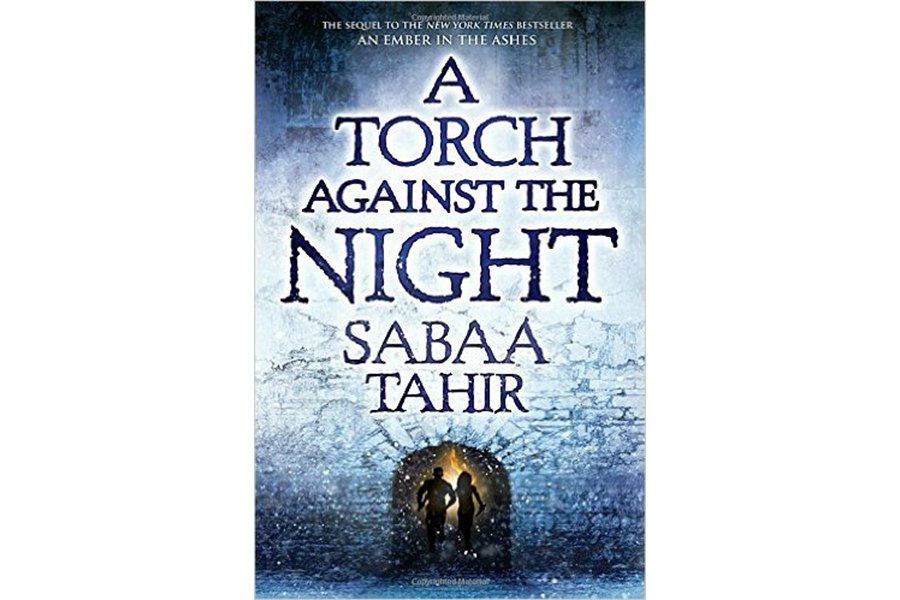'A Torch Against the Night' runs deeper than 'An Ember in the Ashes'
Loading...
Sabaa Tahir's 2015 debut novel "An Ember in the Ashes," introduced readers to a Young Adult fantasy world in which a young woman named Laia, one of the persecuted, peaceful Scholar minority, unexpectedly finds herself joining the Resistance movement that's formed to undercut the tyrannical authority of the Martial Empire and its ranks of elite soldiers called Masks, trained at the notorious Northcliff Academy. Her goal was to rescue her brother Darin from Martial prison, but in the process she encounters a handsome young Mask named Elias and feels an instant attraction for him – a feeling Elias eventually reciprocates even though it complicates his intention to desert from the Empire after graduation and walk away from the world of Northcliff's sadistic commandant, his own mother.
The novel was well-received and gained an intensely devoted audience of readers, but even from such a cursory description, one thing should be obvious: "An Ember in the Ashes" was an intensely derivative work, a story clinging very closely to the formula made standard by such books as "Twilight" and "The Hunger Games," in which a young woman is thrust into prominence through no accomplishment of her own (she's genetically odd, she's the sibling of somebody in trouble, etc.), falls in love with a brooding young man despite his brusque treatment, and proceeds to re-shape the entire world in which she was born – adolescent wish-fulfillment of a very simplistic order. What saved "An Ember in the Ashes" was its raw intensity and lean narrative momentum; despite its slavish fidelity to a certain YA template, the book was very expertly readable.
In interviews at the time, Tahir commented that if the book was sufficiently successful, she'd love to continue telling the stories of this world and these characters. The book was wildly successful, and now we have the sequel, "A Torch Against the Night."
The book's action picks up the very moment where "An Ember in the Ashes" ended, and yet one of the first impressive things about "A Torch Against the Night" is how little it feels like a typical sequel. There are no blocks of exposition wedged into the early chapters in order to bring readers up to speed. Instead, we learn everything we need to know about the previous book and its explosive climax from the characters themselves as they scramble to make sense of this unprecedented thing that's happened. It all feels very organic, and it has the added benefit of not slowing down the action – and action is still very much foremost among the reading pleasures Tahir provides. "A Torch Against the Night" is an unabashed page-turner that scarcely ever pauses for breath.
Laia and Elias are now on the run from the Empire, its evil new Emperor, and his newly-appointed chief assassin, his Blood Shrike – none other than Elias's life-long friend and fellow Northcliff student Helene Aquilla, whose feelings for Elias in "An Ember in the Ashes" ran deep but, thankfully, never quite manifested as that wooliest of YA cliches, the love triangle. In this new book, Tahir so skillfully portrays the conflict between Helene's loyalty to the Empire and her loyalty to Elias that in many important respects "A Torch Against the Night" belongs to Helene, rather than to Laia herself, who for most of the book is every bit as drippy and insipid as she was in the previous installment (“I wanted to tell him that he did what he had to do to save us,” she thinks about Elias at one point, before inevitably adding, “But I couldn't get the words out”).
Tahir keeps the basic elements of her first book in place, the downtrodden Scholars, the “insouciant brutality that is uniquely Martial,” Laia's determination to save her brother from the Empire's most fearsome prison, and Elias's self-sacrificing nobility. But "A Torch Against the Night" is in every way a richer and more generous novel than its predecessor. Tahir gives readers a much more detailed and grounded vision of the world she's created, a much more intriguing exploration of the supernatural elements only sketchily indicated in the first book, and most of all, a far more rewardingly multi-layered treatment of most of her characters. The brutality and sheer speed of the earlier narrative are still firmly in place in this new adventure, but there's the more textured feeling that comes from an author's growing confidence.
The main problem is a common one to YA novels: the main character is a cipher. It's true that by the end of "A Torch Against the Night" she's gained some much-needed grit. But for far too much of the book, she's a quavering doormat, and Tahir's bewildering decision to haul in a totally unconvincing rival love interest doesn't help matters.
But the appearance of this book hints at a long series in which such shortcomings can be addressed. The combination of the hyperkinetic energy of "An Ember in the Ashes" and the more thoughtful complexities of "A Torch Against the Night" hint that such a series will be well worth following.








